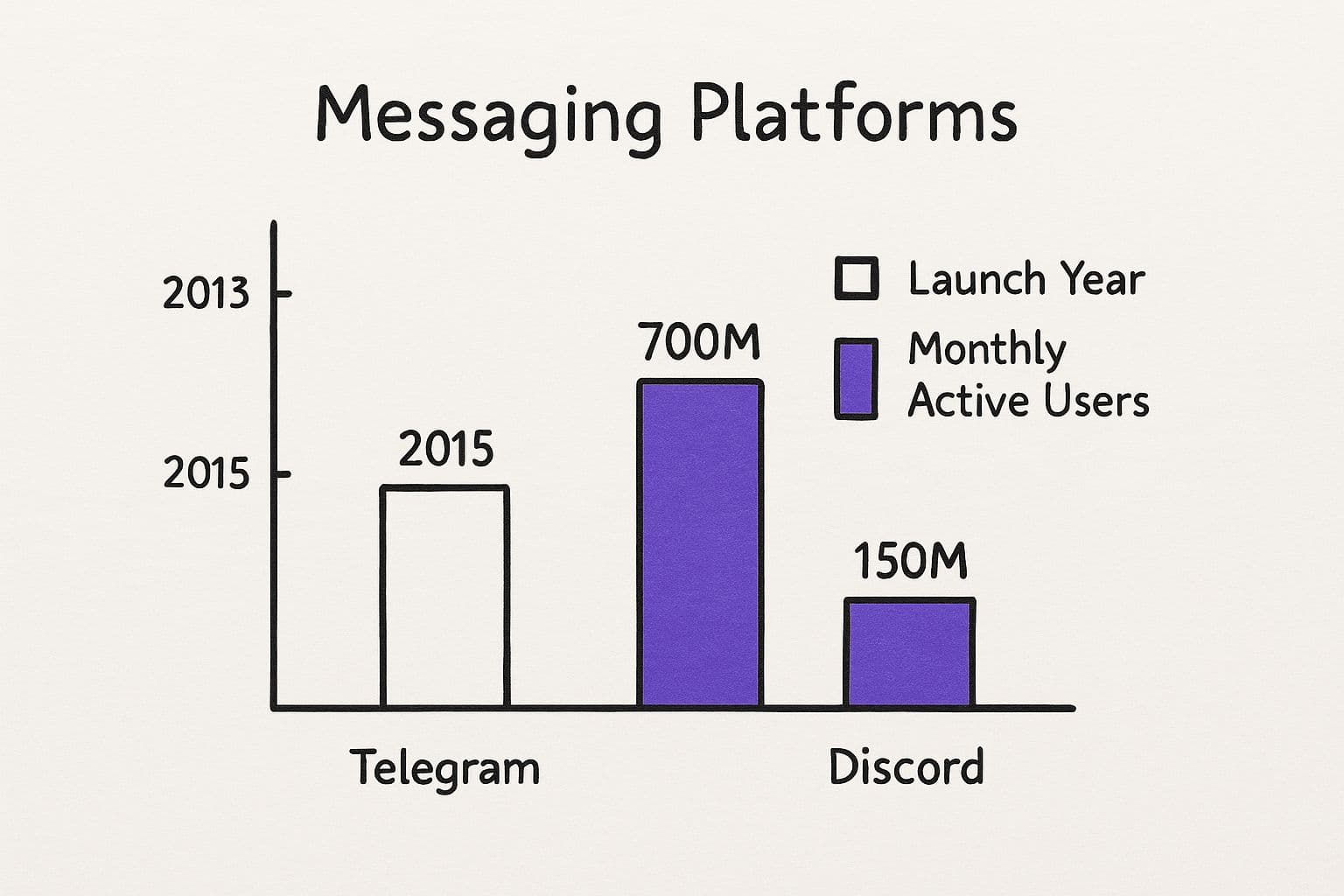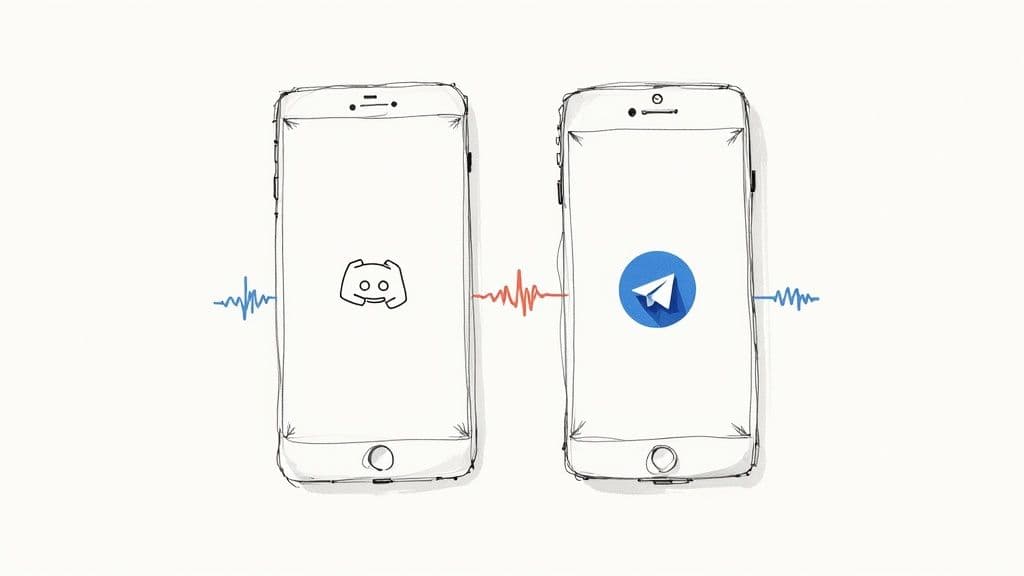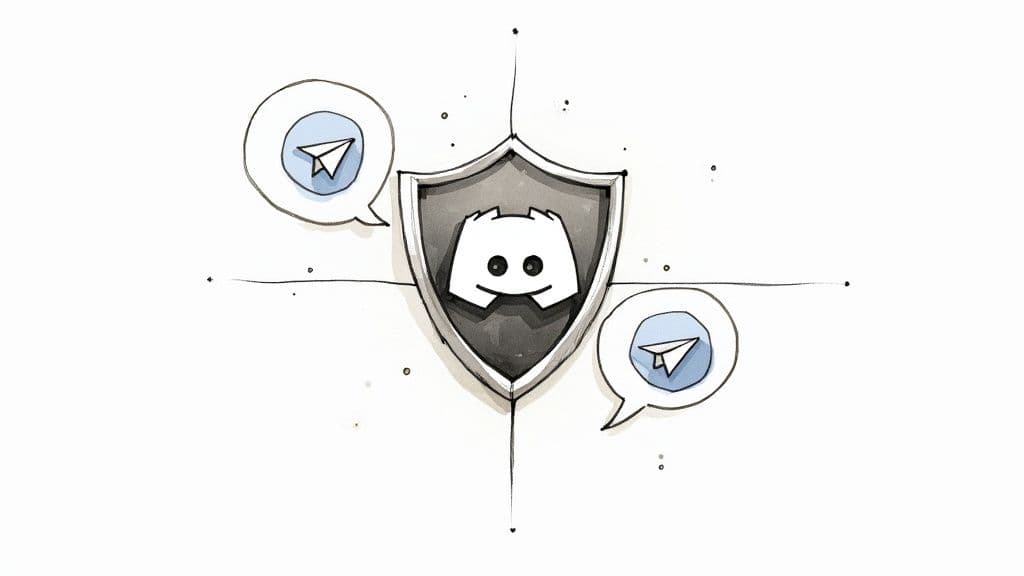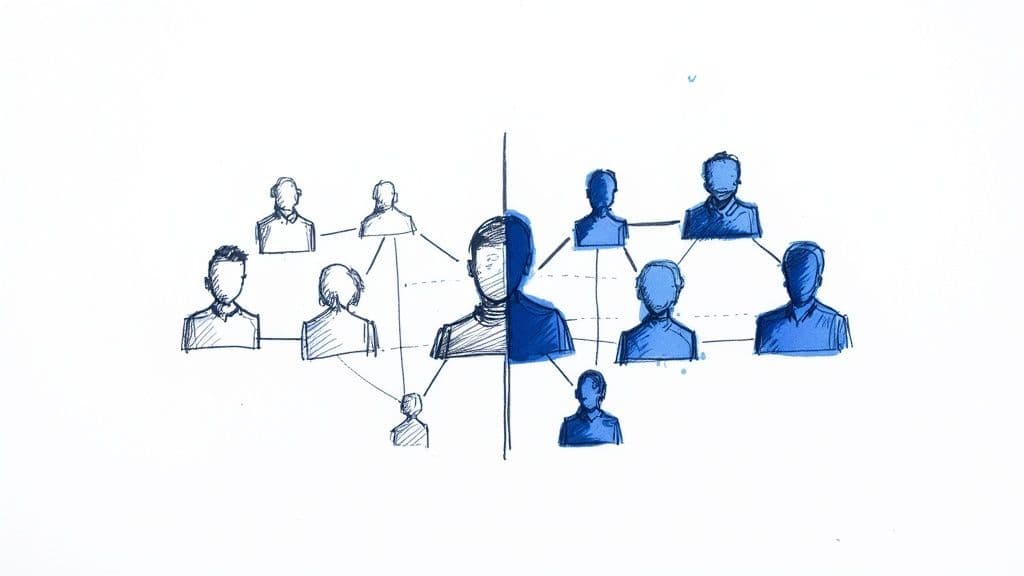When it comes to the Discord vs Telegram debate, the core difference is pretty simple. Discord is built for highly interactive, organised communities—think of it as a customisable clubhouse. In contrast, Telegram is a streamlined messenger that nails privacy, speed, and broadcasting to massive audiences.
Your choice boils down to one question: do you need a deep, feature-rich space for engagement, or a powerful, simple tool for mass communication?
Discord vs Telegram: A High-Level Overview
Picking the right platform is one of the first, most critical decisions for any community builder. While both Discord and Telegram are popular, they were built with fundamentally different goals in mind, and that shapes everything about the user experience. Getting this right from the start can save you the headache of a painful migration later on.
Discord’s whole world is built around servers. Think of a server as a large digital headquarters, complete with different rooms (called channels) for specific topics, voice chats, and activities. This structure is perfect for creating a highly organised hub where deep engagement can flourish. Its gaming roots still show in its best-in-class voice and video features, but it's long since been adopted by everyone from educational groups to creative collectives and major brand communities.
Telegram, on the other hand, puts simplicity and reach first. At its heart, it’s a powerful messenger that scales into enormous groups (up to 200,000 members) and broadcast-style channels with an unlimited number of subscribers. It absolutely excels at one-to-many communication, making it the go-to for news outlets, content creators, and businesses that need to get information out quickly and securely.
This chart gives you a quick snapshot of their market presence, comparing launch dates and user bases.

523091a8-1a1c-415c-8579-da68851daff9.jpg
The numbers tell an interesting story. Although Discord launched later, Telegram has built a much larger user base, showing its massive global appeal. As of mid-2025, Telegram commands a hefty 44.44% of its market category, with Discord trailing at 29.41%. This gap is even more pronounced in places like the UK, where Telegram serves nearly five times as many customers as Discord. You can dig into more data on their market performance to see these trends for yourself.
Key Takeaway: Go with Discord if you want to build an organised, multi-layered community designed for high member interaction. Choose Telegram if your main goal is fast, secure broadcasting to a massive audience, with simpler group chat features.
Quick Comparison: Discord vs Telegram
To cut straight to the chase, here’s a high-level table breaking down the core differences. It’s a handy reference for seeing where each platform shines.
| Feature | Discord | Telegram |
|---|---|---|
| Primary Use Case | Interactive community building | Secure messaging & broadcasting |
| Community Structure | Organised servers with channels | Large groups and channels |
| Voice/Video Chat | Superior quality, always-on | Basic, less feature-rich |
| File Sharing Limit | 25 MB (Free), up to 500 MB (Nitro) | Up to 2 GB per file (Free) |
| Monetisation | Native Server Subscriptions & tools | Needs third-party tools like MyMembers |
Ultimately, this table confirms the main point: Discord is for building a "place," while Telegram is for building a "channel." We'll dive deeper into these features, but this gives you a solid foundation for deciding which path is right for you.
Comparing Community Structure and Management

8930e43a-9ecc-4947-83f1-0355e88be1f0.jpg
The real difference between Discord and Telegram isn't just features—it's philosophy. How you want your community to feel and function comes down to their core architecture. One is a highly organised digital clubhouse; the other is a massive, streamlined broadcast system.
Discord is built entirely around the server. Think of it as your community's headquarters, a place where every conversation has its own dedicated room.
This server-first model is a godsend for communities with multiple topics. A single server is broken down into categories, which then house individual text and voice channels. A creator's server, for instance, could have a "Welcome" category with rules and introductions, an "Updates" category for official posts, and a "General Chat" category with separate channels for gaming, music, and memes.
Everything stays neat, and conversations don't bleed into each other. It’s worth remembering that no matter which platform you choose, you still need to know some effective strategies for social media engagement to make it thrive. Discord's structure just gives you a much more powerful toolkit for putting those strategies into practice.
The Power of Discord Roles
Here’s where Discord really pulls ahead for serious community builders: its granular, role-based permissions. This is the secret sauce. You can create custom roles like "Moderator," "VIP Member," or "Beta Tester" and assign them hyper-specific powers.
Want a role that can access private channels but can't mute other users? Done. Need to give someone a special coloured name to show they're a top supporter? Easy.
This system is unbelievably powerful. It’s the foundation for creating tiered access, reward systems, and a clear moderation team, making your community feel professional and well-managed, even as it scales. With 200 million monthly active users globally as of May 2025, Discord has proven it can handle communities of all sizes, far beyond its original 18-24 year-old gaming demographic.
Telegram’s Streamlined Approach
Telegram, on the other hand, keeps things much simpler. Its structure is flatter, faster, and built for scale and broadcasting, not complex organisation. It all boils down to two things: Groups and Channels.
- Telegram Groups: These are essentially massive chat rooms. Supergroups can hold up to 200,000 members, making them perfect for huge, free-flowing discussions or live Q&As where you want everyone in one place. It’s a single, continuous firehose of conversation.
- Telegram Channels: This is your one-to-many broadcast tool. Channels have an unlimited number of subscribers, but only admins can post. This makes them ideal for announcements, newsletters, or dropping content when you don’t want the feed cluttered with replies.
So, what’s the bottom line for community managers? If you need a forum-like space with different rooms for different topics and deep control over who can do what, Discord is the clear winner. If your goal is to manage a gigantic, single-feed chat or broadcast to a massive audience with zero friction, Telegram’s structure is built for the job.
Telegram’s simplicity is its strength and why so many creators love it. But be warned: managing a massive, single-feed group chat can descend into chaos without strict rules and active moderation. If you're going the Telegram route, our guide on essential Telegram community management tips is a must-read to keep things from going off the rails.
Analysing Core Features and Functionality

a33d64b9-f08a-45ab-b893-189e95db31f7.jpg
Beyond the high-level community structure, the day-to-day feel of running a group on Discord versus Telegram comes down to their core features. Both platforms nail the basics of messaging, of course. But it’s their specialised tools that reveal who they’re really built for.
Your decision will almost certainly hinge on which platform’s unique toolkit aligns with what you want your members to actually do.
Let's be clear: Discord’s killer feature is its voice and video setup. It was built from the ground up for real-time, low-latency communication, a holdover from its gaming roots. Its "always-on" voice channels are a game-changer, letting members drop in and out of conversations as if they were walking into a room. This is perfect for live Q&A sessions, collaborative work, or just casual hangouts.
Telegram’s voice and video are… fine. They work for one-on-one calls, but they lack the polish and community-centric design of Discord's offering. It feels more like a standard calling feature tacked on, not an integrated community space.
But where Telegram completely flips the script is in its handling of media and files.
Communication and Media Handling
When it comes to sharing large files, Telegram has a massive advantage, especially for users on its free tier. It lets you send files up to 2 GB each, all kept forever on its unlimited cloud storage. This makes it an incredible tool for distributing chunky resources like video tutorials, high-res design assets, or even software.
Discord, on the other hand, puts a tight leash on free users, with a tiny 25 MB upload limit. You can bump this up to 500 MB with a paid Nitro subscription, but Telegram gives away huge file-sharing capacity to everyone for free. This one difference makes Telegram the undisputed champion for any community built around distributing large files.
Key Insight: Choose Discord if your community is built on live voice and video interaction—think live events, coaching, or co-working sessions. Go with Telegram if your main goal is to share large files and give members a permanent, easily searchable content archive.
The World of Bots and Customisation
Both platforms have powerful bot ecosystems, but they approach them from different angles. Discord’s bot library is massive and ridiculously easy to use. Community managers can add bots for moderation, music, games, and polls with a few clicks, no coding required. Bots like MEE6 and Dyno are practically standard issue for any serious server.
Telegram's bots are more developer-focused but just as mighty, built on an open API. They're often used for complex automations, payment processing, and building interactive services right inside the app. For anyone looking to monetise, a custom Telegram bot is a popular way to connect a payment gateway to grant access to a private channel.
Customisation also shows their different philosophies. Discord is all about server-specific culture, with custom emojis and stickers that become inside jokes. Telegram is famous for its massive library of sticker packs, which are more of a platform-wide feature that anyone can use.
So, let's break down the key functionalities side-by-side.
Feature Breakdown: Discord vs Telegram
This table cuts through the noise and compares the features that matter most for community managers, from communication tools to automation potential.
| Functionality | Discord | Telegram | Best For |
|---|---|---|---|
| Voice & Video | Superior quality, low-latency. "Always-on" voice channels for drop-in chats. Screen sharing and server-wide video calls. | Functional for standard calls. Group video calls supported but less integrated for community events. | Discord: Live events, coaching, collaborative work, and gaming. |
| File Sharing | Free: 25 MB limit. Paid (Nitro): Up to 500 MB. Limited server storage. | Free: 2 GB limit per file. Unlimited cloud storage for all media and files. | Telegram: Distributing large files like courses, videos, and software. |
| Bots | Huge library of easy-to-install, no-code bots (e.g., MEE6, Dyno) for moderation, games, and utilities. | Powerful, developer-focused API for creating custom bots for automation, payments, and complex tasks. | Discord: Quick, easy setup for community management. Telegram: Custom, complex automations and monetisation. |
| Customisation | Server-specific custom emojis and stickers. Detailed role and permission management. Server templates. | Platform-wide sticker packs. Customisable chat folders and themes. More streamlined interface. | Discord: Creating a unique, branded community culture. Telegram: User-level personalisation and organisation. |
Ultimately, it comes down to this: Discord’s features are geared towards building a rich, self-contained, and highly interactive community hub. In contrast, Telegram prioritises speed, massive reach, and powerful content distribution, making it an unbeatable tool for broadcasting and content delivery.
The right platform is the one that best supports the kind of interactions you want to create.
Evaluating Security, Privacy, and User Trust
When you're choosing between Discord and Telegram, security and privacy aren't just tick-box features; they represent a fundamental split in philosophy. Your decision will come down to what you care about more: absolute confidentiality for private chats or a powerful arsenal for keeping a large community safe and orderly.

73de7a47-797e-4f63-81d9-5c10b8b5f65d.jpg
One platform prioritises user-to-user privacy above all else. The other centres its entire security model on platform-wide integrity and admin control. They're built for different threats.
Telegram has built its brand on privacy, but you need to know exactly what you’re getting. Its famed end-to-end encryption (E2EE) isn't a blanket feature that protects everything by default. It only applies to one-on-one "Secret Chats," a specific mode you have to actively start.
For everything else—standard one-on-one chats and all group communications—Telegram uses server-client encryption. This means Telegram holds the encryption keys on its servers. For most, that's a perfectly fine trade-off for killer features like seamless multi-device sync and unlimited cloud storage, but it’s a crucial distinction.
Discord’s Focus on Community Safety
Discord plays a different game. Its security isn't about hiding your messages from the platform itself. Instead, it’s about giving server admins the tools to build a fortress around their community.
All communication on Discord—voice, video, and text—is encrypted in transit and at rest, but critically, it is not end-to-end encrypted. This design choice allows Discord to scan for malicious content and enforce its Terms of Service, which is vital for policing large, public-facing servers.
Discord is packed with a suite of safety features built for community managers:
- Two-Factor Authentication (2FA): An essential layer of security that should be mandatory for admins to protect accounts from being compromised.
- Server Verification: Official servers for brands, creators, and public figures can get a verification badge, which signals trust and authenticity to members.
- Powerful Moderation Tools: This is where Discord shines. Admins get granular control over permissions, auto-moderation filters, and user access, with an entire ecosystem of bots to automate takedowns and safety patrols.
This philosophical split is the key differentiator. Telegram gives you the option for absolute privacy between two people. Discord gives you the tools for maintaining public safety at scale.
So, which one is for you? It's all about your threat model. If your main worry is a third party potentially accessing your private conversations, Telegram's Secret Chats offer superior confidentiality.
But if your goal is to grow a large, vibrant community and you need to protect it from raids, spam, and toxic behaviour, Discord's moderation toolkit is in a league of its own. It’s purpose-built to give you the control you need to curate a safe and welcoming space for hundreds or even thousands of members.
Comparing Monetisation and Business Models

embed
Turning your community from a passion project into a proper business is where the real work begins. When you stack Discord against Telegram on monetisation, you’re not just looking at features—you’re seeing two completely different philosophies in action. One gives you a neat, tidy, all-in-one package, while the other hands you a box of powerful LEGO bricks and tells you to build whatever you want.
Discord takes the direct route with its built-in Server Subscriptions. This feature lets you create tiered membership plans right inside your server. No fuss. You can offer paying members exclusive channels, shiny roles, and other perks without ever leaving the platform.
For creators who want a simple, out-of-the-box solution, this is a massive win. It deals with payments, automates role assignments, and gives subscribers a smooth experience. You can get a paid community off the ground fast, even if you’re not a tech wizard. Discord also plays nice with platforms like Patreon, letting you sync supporter tiers directly to server roles.
Discord’s Integrated Monetisation Path
With Server Subscriptions, Discord has laid out a clear road for community-based businesses. You set up your pricing tiers, define the perks for each, and build a value ladder that encourages members to climb. It’s clean and straightforward.
- Premium Content Channels: Gate off your best tutorials, behind-the-scenes content, or early-access info.
- Exclusive Roles: Give paying members a special role with a unique colour and permissions. It’s a simple status symbol that works wonders.
- VIP Community Access: Create private chat and voice channels just for subscribers. This is perfect for fostering that close-knit, high-value community feel.
This native feature massively lowers the barrier to entry. You can spend your time creating amazing content instead of wrestling with payment gateways and complex setups.
Telegram’s Flexible, Third-Party Approach
Telegram, on the other hand, has zero built-in monetisation tools. Nothing. Instead, it offers a ridiculously powerful and open API that has fuelled a thriving ecosystem of third-party tools. This approach offers incredible flexibility but definitely requires more hands-on work to get going.
The go-to strategy here is to create a private Telegram channel or group and then use a bot to manage who gets in. This is where tools like MyMembers become essential. They act as the bridge connecting your community to your payment processor, like Stripe. For anyone serious about this model, digging into how to use Telegram for business is the first critical step.
Key Difference: Discord gives you a user-friendly, ready-made subscription system straight out of the box. Telegram provides the raw materials—a powerful API and third-party tools—to build a completely custom monetisation engine. You get more control, but it requires more technical setup.
A typical Telegram setup looks like this: a user interacts with a payment bot, which sends them to a checkout page. Once they pay, the bot automatically adds them to your private channel. If their subscription ends, the bot just as easily removes them. It’s a powerful system that can handle one-off fees, recurring subscriptions, and custom sales funnels.
While it demands a bit more effort upfront, this model gives you total ownership over your business logic, your customer data, and your brand experience. It's the choice for creators who want full control.
How to Choose The Right Platform for You
The whole "Discord vs. Telegram" debate boils down to one simple question: what’s the point of your community? Once you get clear on that, the right choice usually becomes obvious. This isn’t about which platform is universally ‘better’, but which one is the right tool for the job you need to do.
Your decision should really be guided by the kind of vibe and interaction you want to create.
When to Choose Discord
Discord is the undisputed king of highly interactive, multi-layered communities. It's the right call when your goal is to build a genuine 'home' for your members, not just a noticeboard for your announcements.
Its real power lies in the structure. You can create a server with dozens of distinct text and voice channels, allowing for all sorts of topic-specific conversations to happen at once without it descending into chaos.
Go with Discord if your project is all about:
- Deep Engagement: You want members talking to each other in various channels, from general chat and memes to super-niche interests.
- Live Interaction: Your community thrives on live events. Think Q&As, workshops, co-working sessions, or gaming nights. Discord’s voice and video quality is built for this stuff, and it just works.
- Structured Organisation: You need to build a space that feels professional and organised, with clear roles, permissions, and powerful moderation tools to manage a growing user base without losing your mind.
If you're building a brand fanbase, an educational hub, or a collaborative project, Discord’s ability to create an immersive, organised world is tough to beat.
The decision really hinges on interaction style. Discord is a bustling community centre with lots of different rooms for different conversations. Telegram is a powerful megaphone connected to a single, massive town square.
When to Choose Telegram
Telegram, on the other hand, is the master of large-scale broadcasting and streamlined communication. Its strength is in its raw power and simplicity, letting you reach a massive audience with almost zero friction.
Choose Telegram if your main goals are:
- Massive Broadcasting: You need to get updates, news, or content out to a potentially unlimited number of subscribers using a Channel. It’s a direct line to your audience’s pocket.
- Large-Scale Discussion: You want to host enormous, free-flowing conversations in a single Supergroup that can hold up to 200,000 members.
- Content & File Distribution: You plan on sharing big files—up to 2 GB each. This is perfect for things like videos, course materials, or high-resolution design assets.
News organisations, content creators with huge followings, and businesses that need secure, simple client communication will find Telegram’s focused toolset is exactly what they need. And if you’re looking to monetise that huge reach, there are great guides on how to make money on Telegram that dig into the business potential of its broadcast-first model.
Frequently Asked Questions
When you're weighing up Discord vs Telegram, you quickly run into a few critical questions. Getting these right from the start is non-negotiable if you want to avoid a massive headache later on.
Which Platform Is Better For a Paid Membership?
Both can get the job done, but they take completely different roads to get there.
Discord gives you a clean, built-in path with its native Server Subscriptions feature. This lets you set up tiered roles and access directly inside the app. If you want something that just works out of the box with minimal fuss, it's a solid choice.
Telegram, true to its nature, is more of a wild west. You'll need third-party tools (like MyMembers, for instance) and bots to manage paid access to your private channels. It takes a bit more setup, but the trade-off is huge flexibility in how you handle payments and build your funnel.
For a simple, integrated experience, Discord has the edge. For total control and the ability to customise every last detail, Telegram’s open ecosystem is king.
Key Takeaway: There’s no such thing as an "easy" migration between these platforms. Moving a community is a painful, manual process that means starting from scratch. That's why you have to pick the right platform on day one, based on where you see your community going long-term.
Is Telegram More Secure Than Discord?
This all comes down to what you mean by ‘secure’.
Telegram built its reputation on end-to-end encrypted (E2EE) ‘Secret Chats’ for one-on-one messages. For that specific use case, it offers a level of privacy that’s hard to beat. But—and this is a big but—its standard group chats and channels are not E2EE.
Discord, on the other hand, encrypts all your data in transit and at rest, but its real security focus is on community safety and moderation. It gives admins a massive toolkit to shield members from raids, spam, and toxic content.
So, if you need maximum confidentiality for private conversations, choose Telegram. If your priority is building a safe, well-managed community environment protected from bad actors, Discord’s toolset is far superior.
Ready to turn your Telegram community into a proper business? With MyMembers, you can launch and manage paid subscriptions effortlessly, no code needed. Get set up in minutes and turn your audience into a predictable income stream. Learn how MyMembers can help you monetise your Telegram community today.
